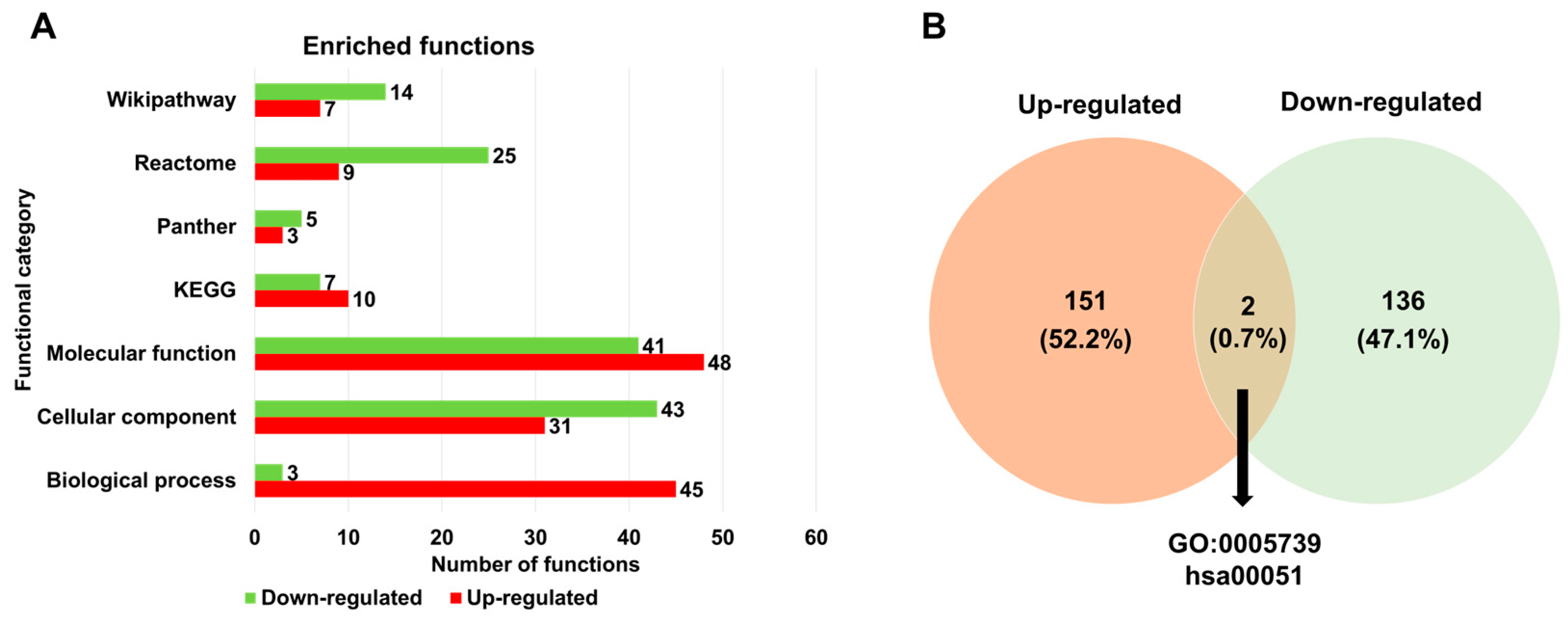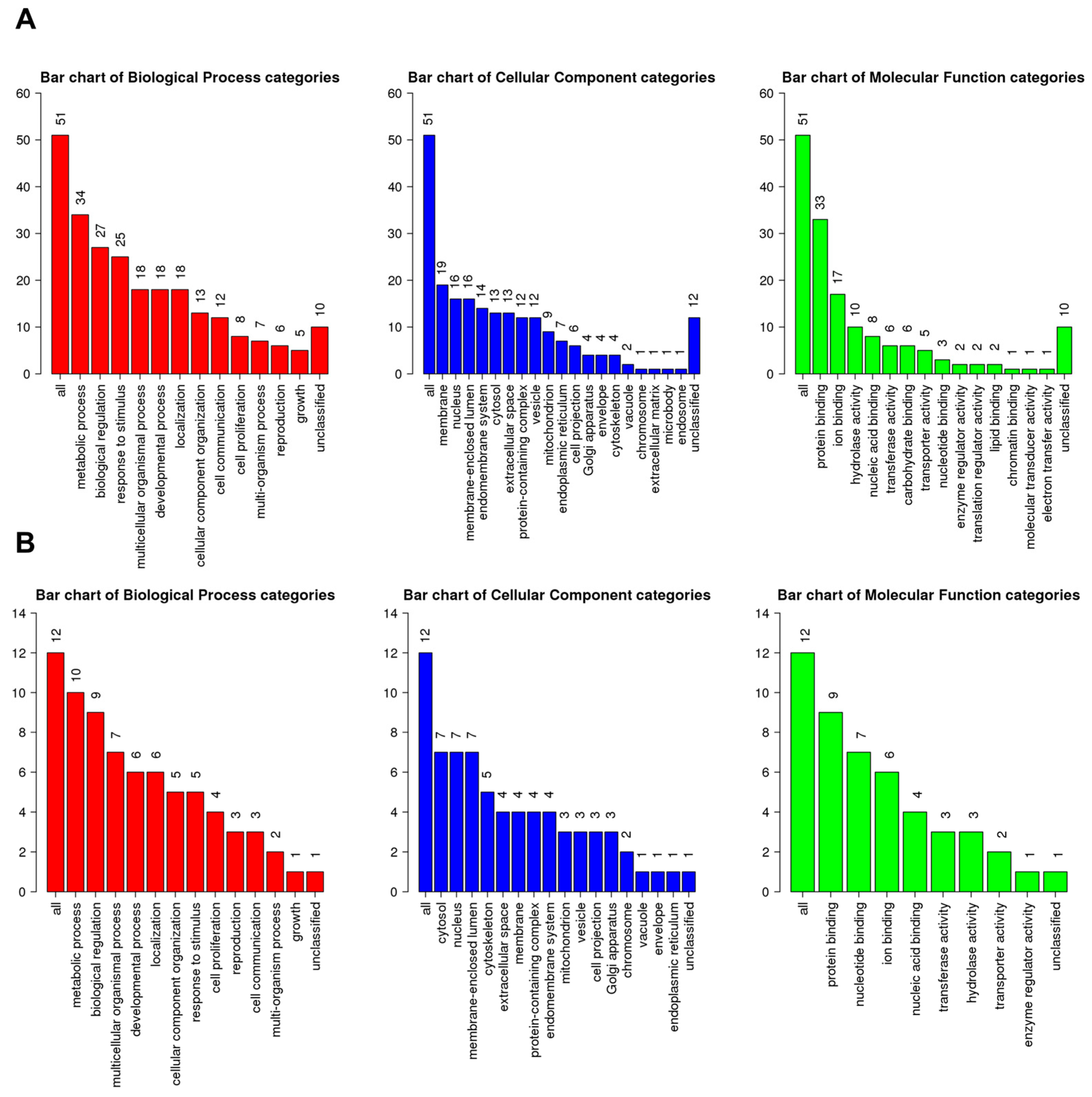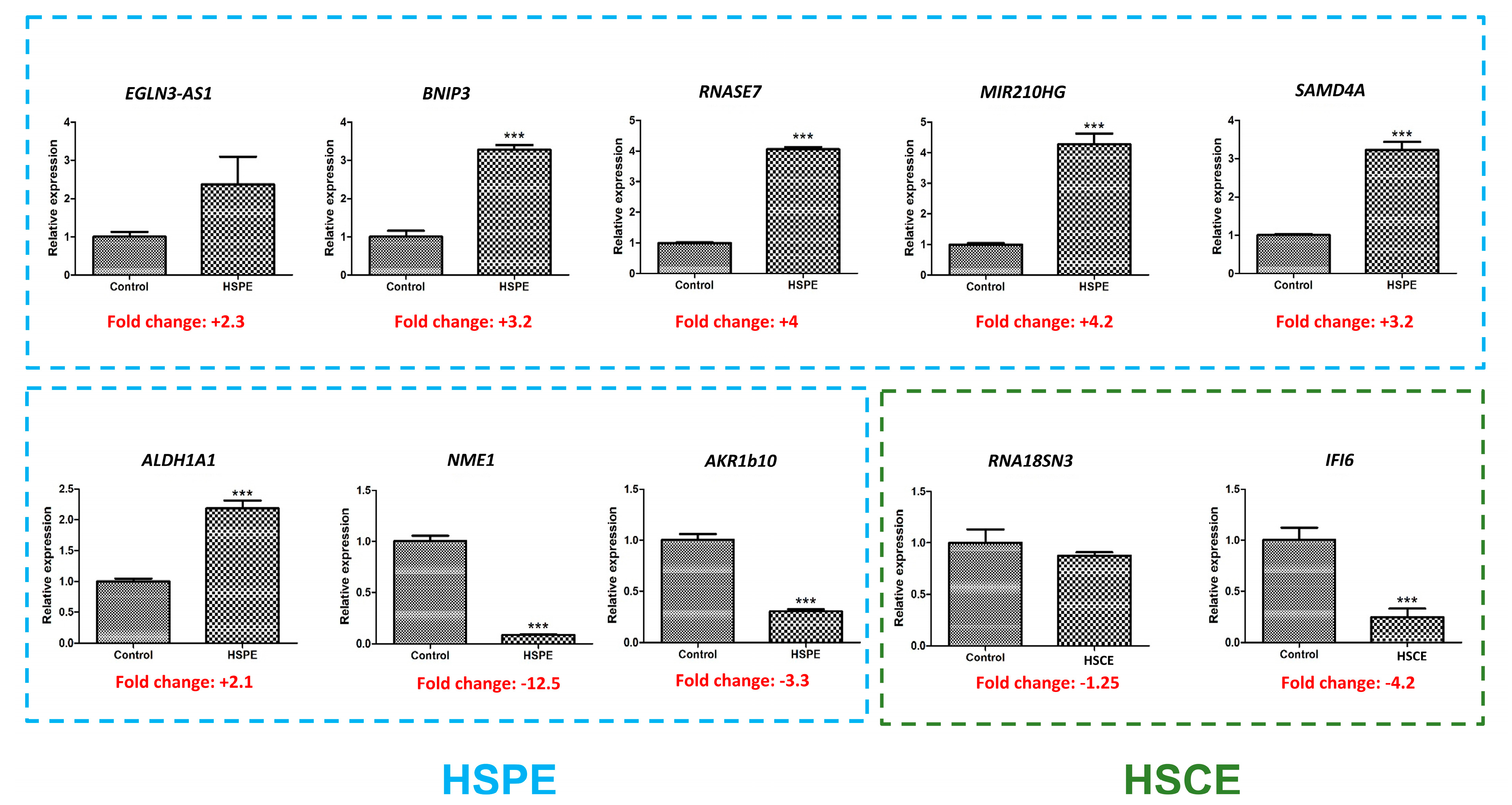Comparative Analysis of Water Extracts from Roselle (Hibiscus sabdariffa L.) Plants and Callus Cells: Constituents, Effects on Human Skin Cells, and Transcriptome Profiles
Abstract
1. Introduction
2. Results
2.1. Generation and Propagation of Plant Cells from Roselle Leaves
2.2. Identification of Components in Water Extracts of Hibiscus sabdariffa Using High-Performance Liquid Chromatography
2.3. Assessment of the Cosmetical Effects of HSCE through In Vitro Studies
2.4. Transcriptomic Analysis of HaCaT Cells in Response to Extracts of HS Derived from Plant and Callus
2.5. Identification of Differentially Expressed RNAs in Response to HS Extract Treatment
2.6. Functional Classification of Differentially Expressed RNAs Associated with HSPE Treatment
2.7. Functional Categorization of Genes Up-Regulated by HSPE
2.8. Functional Classification of Genes Down-Regulated by HSPE Treatment
2.9. Identification of Differentially Expressed RNAs Associated with HSCE
2.10. Confirmation of RNA Sequencing Results by Real Time RT-PCR
3. Discussion
4. Materials and Methods
4.1. Induction and Propagation of Plant Cells from Roselle Leaves
4.2. Preparation of Two Different Roselle Extracts through Heat Extraction Method
4.3. HPLC Analysis of Water Extracts from Hibiscus sabdariffa
4.4. Culture and Treatment of Human Keratinocyte Cells with Roselle Extracts
4.5. Assessment of HSCE Cell Cytotoxicity Using the CCK-8 Assay
4.6. Quantificiation of Melanin Content following HSCE Treatment
4.7. Expression Analysis of FLG and SOD1 Marker Genes by Real-Time Reverse Transcription (RT-PCR)
4.8. Total RNA Isolation, Library Preparation, and RNA Sequencing for Transcriptome Analysis
4.9. Identification of Differentially Expressed Genes through Mapping of RNA-seq Reads
4.10. Functional Characterization of Differentially Expressed Genes (DEGs) by Gene Ontology (GO) Enrichment Analysis
5. Conclusions
Supplementary Materials
Author Contributions
Funding
Institutional Review Board Statement
Informed Consent Statement
Data Availability Statement
Conflicts of Interest
References
- Mahadevan, N.; Kamboj, P. Hibiscus sabdariffa Linn.—An overview. Nat. Prod. Radiance 2009, 8, 77–83. [Google Scholar]
- Ansari, M.; Eslaminejad, T.; Sarhadynejad, Z.; Eslaminejad, T. An overview of the roselle plant with particular reference to its cultivation, diseases and usages. Eur. J. Med. Plants 2013, 3, 135. [Google Scholar] [CrossRef]
- Cid-Ortega, S.; Guerrero-Beltrán, J. Roselle calyces (Hibiscus sabdariffa), an alternative to the food and beverages industries: A review. J. Food Sci. Technol. 2015, 52, 6859–6869. [Google Scholar] [CrossRef]
- Pinela, J.; Prieto, M.; Pereira, E.; Jabeur, I.; Barreiro, M.F.; Barros, L.; Ferreira, I.C. Optimization of heat-and ultrasound-assisted extraction of anthocyanins from Hibiscus sabdariffa calyces for natural food colorants. Food Chem. 2019, 275, 309–321. [Google Scholar] [CrossRef] [PubMed]
- Riaz, G.; Chopra, R. A review on phytochemistry and therapeutic uses of Hibiscus sabdariffa L. Biomed. Pharmacother. 2018, 102, 575–586. [Google Scholar] [CrossRef] [PubMed]
- Izquierdo-Vega, J.A.; Arteaga-Badillo, D.A.; Sánchez-Gutiérrez, M.; Morales-González, J.A.; Vargas-Mendoza, N.; Gómez-Aldapa, C.A.; Castro-Rosas, J.; Delgado-Olivares, L.; Madrigal-Bujaidar, E.; Madrigal-Santillán, E. Organic acids from Roselle (Hibiscus sabdariffa L.)—A brief review of its pharmacological effects. Biomedicines 2020, 8, 100. [Google Scholar] [CrossRef] [PubMed]
- Salah, A.; Gathumbi, J.; Vierling, W. Inhibition of intestinal motility by methanol extracts of Hibiscus sabdariffa L. (Malvaceae) in rats. Phytother. Res. 2002, 16, 283–285. [Google Scholar] [CrossRef] [PubMed]
- Wu, H.-Y.; Yang, K.-M.; Chiang, P.-Y. Roselle anthocyanins: Antioxidant properties and stability to heat and pH. Molecules 2018, 23, 1357. [Google Scholar] [CrossRef]
- Da-Costa-Rocha, I.; Bonnlaender, B.; Sievers, H.; Pischel, I.; Heinrich, M. Hibiscus sabdariffa L.—A phytochemical and pharmacological review. Food Chem. 2014, 165, 424–443. [Google Scholar] [CrossRef]
- Hidalgo, D.; Sanchez, R.; Lalaleo, L.; Bonfill, M.; Corchete, P.; Palazon, J. Biotechnological production of pharmaceuticals and biopharmaceuticals in plant cell and organ cultures. Curr. Med. Chem. 2018, 25, 3577–3596. [Google Scholar] [CrossRef]
- Wolf, J.B. Principles of transcriptome analysis and gene expression quantification: An RNA-seq tutorial. Mol. Ecol. Resour. 2013, 13, 559–572. [Google Scholar] [CrossRef] [PubMed]
- Wang, Z.; Gerstein, M.; Snyder, M. RNA-Seq: A revolutionary tool for transcriptomics. Nat. Rev. Genet. 2009, 10, 57–63. [Google Scholar] [CrossRef] [PubMed]
- Cho, W.K.; Kim, H.-I.; Kim, S.-Y.; Seo, H.H.; Song, J.; Kim, J.; Shin, D.S.; Jo, Y.; Choi, H.; Lee, J.H. Anti-aging effects of Leontopodium alpinum (Edelweiss) callus culture extract through transcriptome profiling. Genes 2020, 11, 230. [Google Scholar] [CrossRef]
- Cho, W.K.; Paek, S.H.; Kim, S.-Y.; Jang, S.J.; Lee, S.; Choi, H.; Jo, Y.; Lee, J.H.; Moh, S.H. Comparative Transcriptome Profiles of Human HaCaT Cells in Response to Gynostemma pentaphyllum Extracts Obtained Using Three Independent Methods by RNA Sequencing. Life 2023, 13, 423. [Google Scholar] [CrossRef]
- Cho, W.K.; Kim, H.I.; Paek, S.H.; Kim, S.Y.; Hyun Seo, H.; Song, J.; Lee, O.H.; Min, J.; Lee, S.J.; Jo, Y. Gene expression profile of human follicle dermal papilla cells in response to Camellia japonica phytoplacenta extract. FEBS Open Bio 2021, 11, 633–651. [Google Scholar] [CrossRef]
- Fehér, A. Callus, dedifferentiation, totipotency, somatic embryogenesis: What these terms mean in the era of molecular plant biology? Front. Plant Sci. 2019, 10, 536. [Google Scholar] [CrossRef]
- Abeda, H.Z.; Kouassi, M.K.; Yapo, K.D.; Koffi, E.; Sie, R.; Kone, M.; Kouakou, H.T. Production and enhancement of anthocyanin in callus line of roselle (Hibiscus sabdariffa L.). Int. J. Recent Biotechnol. 2014, 2, 45–56. [Google Scholar]
- Medina, T.J.T.; Cardenas, L.B. Induction of Anthocyanin Production in Established Callus Cultures of Roselle (Hibiscus sabdariffa L.) Using Yeast Extract. Asian J. Biotechnol. Bioresour. Technol. 2019, 4, 1–8. [Google Scholar] [CrossRef]
- Parthasarathy, A.; Cross, P.J.; Dobson, R.C.; Adams, L.E.; Savka, M.A.; Hudson, A.O. A three-ring circus: Metabolism of the three proteogenic aromatic amino acids and their role in the health of plants and animals. Front. Mol. Biosci. 2018, 5, 29. [Google Scholar] [CrossRef]
- Tahergorabi, Z.; Khazaei, M. A review on angiogenesis and its assays. Iran. J. Basic Med. Sci. 2012, 15, 1110–1126. [Google Scholar]
- Tang, J.; Deng, H.; Wang, Z.; Zha, H.; Liao, Q.; Zhu, C.; Chen, X.; Sun, X.; Jia, S.; Ouyang, G. EGLN1 prolyl hydroxylation of hypoxia-induced transcription factor HIF1α is repressed by SET7-catalyzed lysine methylation. J. Biol. Chem. 2022, 298, 101961. [Google Scholar] [CrossRef] [PubMed]
- Sen, C.K. Wound healing essentials: Let there be oxygen. Wound Repair Regen. 2009, 17, 1–18. [Google Scholar] [CrossRef]
- Hong, W.X.; Hu, M.S.; Esquivel, M.; Liang, G.Y.; Rennert, R.C.; McArdle, A.; Paik, K.J.; Duscher, D.; Gurtner, G.C.; Lorenz, H.P. The role of hypoxia-inducible factor in wound healing. Adv. Wound Care 2014, 3, 390–399. [Google Scholar] [CrossRef] [PubMed]
- Baumer, S.; Keller, L.; Holtmann, A.; Funke, R.; August, B.; Gamp, A.; Wolburg, H.; Wolburg-Buchholz, K.; Deutsch, U.; Vestweber, D. Vascular endothelial cell–specific phosphotyrosine phosphatase (VE-PTP) activity is required for blood vessel development. Blood 2006, 107, 4754–4762. [Google Scholar] [CrossRef] [PubMed]
- Broermann, A.; Winderlich, M.; Block, H.; Frye, M.; Rossaint, J.; Zarbock, A.; Cagna, G.; Linnepe, R.; Schulte, D.; Nottebaum, A.F. Dissociation of VE-PTP from VE-cadherin is required for leukocyte extravasation and for VEGF-induced vascular permeability in vivo. J. Exp. Med. 2011, 208, 2393–2401. [Google Scholar] [CrossRef] [PubMed]
- Bignon, M.; Pichol-Thievend, C.; Hardouin, J.; Malbouyres, M.; Bréchot, N.; Nasciutti, L.; Barret, A.; Teillon, J.; Guillon, E.; Etienne, E. Lysyl oxidase-like protein-2 regulates sprouting angiogenesis and type IV collagen assembly in the endothelial basement membrane. Blood J. Am. Soc. Hematol. 2011, 118, 3979–3989. [Google Scholar] [CrossRef]
- Maulik, N.; Das, D.K. Redox signaling in vascular angiogenesis. Free Radic. Biol. Med. 2002, 33, 1047–1060. [Google Scholar] [CrossRef] [PubMed]
- Qie, S.; Sang, N. Stanniocalcin 2 (STC2): A universal tumour biomarker and a potential therapeutical target. J. Exp. Clin. Cancer Res. 2022, 41, 161. [Google Scholar] [CrossRef] [PubMed]
- Ikeda, H.; Kakeya, H. Targeting hypoxia-inducible factor 1 (HIF-1) signaling with natural products toward cancer chemotherapy. J. Antibiot. 2021, 74, 687–695. [Google Scholar] [CrossRef]
- Zhao, Y.; Chard Dunmall, L.S.; Cheng, Z.; Wang, Y.; Si, L. Natural products targeting glycolysis in cancer. Front. Pharmacol. 2022, 13, 4610. [Google Scholar] [CrossRef]
- Nie, K.; Li, J.; He, X.; Wang, Y.; Zhao, Q.; Du, M.; Sun, H.; Wang, J.; Lyu, J.; Fang, H. COX6B2 drives metabolic reprogramming toward oxidative phosphorylation to promote metastasis in pancreatic ductal cancer cells. Oncogenesis 2020, 9, 51. [Google Scholar] [CrossRef]
- Cheng, C.-C.; Wooten, J.; Gibbs, Z.A.; McGlynn, K.; Mishra, P.; Whitehurst, A.W. Sperm-specific COX6B2 enhances oxidative phosphorylation, proliferation, and survival in human lung adenocarcinoma. Elife 2020, 9, e58108. [Google Scholar] [CrossRef]
- Choquet, D.; Triller, A. The dynamic synapse. Neuron 2013, 80, 691–703. [Google Scholar] [CrossRef]
- Jia, H.; Mo, W.; Hong, M.; Jiang, S.; Zhang, Y.-Y.; He, D.; Yu, D.; Shi, Y.; Cao, J.; Xu, X. Interferon-α inducible protein 6 (IFI6) confers protection against ionizing radiation in skin cells. J. Dermatol. Sci. 2020, 100, 139–147. [Google Scholar] [CrossRef] [PubMed]
- Hao, J.; Sun, M.; Li, D.; Zhang, T.; Li, J.; Zhou, D. An IFI6-based hydrogel promotes the healing of radiation-induced skin injury through regulation of the HSF1 activity. J. Nanobiotechnol. 2022, 20, 288. [Google Scholar] [CrossRef] [PubMed]
- Kucukural, A.; Yukselen, O.; Ozata, D.M.; Moore, M.J.; Garber, M. DEBrowser: Interactive differential expression analysis and visualization tool for count data. BMC Genom. 2019, 20, 6. [Google Scholar] [CrossRef]
- Liao, Y.; Wang, J.; Jaehnig, E.J.; Shi, Z.; Zhang, B. WebGestalt 2019: Gene set analysis toolkit with revamped UIs and APIs. Nucleic Acids Res. 2019, 47, W199–W205. [Google Scholar] [CrossRef] [PubMed]










| Index | Condition | Treatment | Library Name | Replicate |
|---|---|---|---|---|
| 1 | Control | Distilled water | DW-R1 | 1 |
| 2 | Control | Distilled water | DW-R2 | 2 |
| 3 | Control | Distilled water | DW-R3 | 3 |
| 4 | HSPE | HS extract from plants | HSPE-R1 | 1 |
| 5 | HSPE | HS extract from plants | HSPE-R2 | 2 |
| 6 | HSPE | HS extract from plants | HSPE-R3 | 3 |
| 7 | HSCE | HS extract from callus | HSCE-R1 | 1 |
| 8 | HSCE | HS extract from callus | HSCE-R2 | 2 |
| 9 | HSCE | HS extract from callus | HSCE-R3 | 3 |
| Library Name | Total Read (bp) | Total Reads | GC(%) | AT(%) | Q20(%) | Q30(%) |
|---|---|---|---|---|---|---|
| DW-R1 | 10,517,649,342 | 104,135,142 | 40.2 | 59.8 | 98.5 | 95.5 |
| DW-R2 | 13,311,500,636 | 131,797,036 | 41.1 | 58.9 | 98.6 | 95.7 |
| DW-R3 | 11,736,440,986 | 116,202,386 | 43 | 57 | 98.5 | 95.6 |
| HSPE-R1 | 10,081,467,712 | 99,816,512 | 41.2 | 58.8 | 98.5 | 95.7 |
| HSPE-R2 | 10,758,263,258 | 106,517,458 | 40.8 | 59.2 | 98.5 | 95.4 |
| HSPE-R3 | 13,290,280,334 | 131,586,934 | 42.2 | 57.8 | 98.5 | 95.6 |
| HSCE-R1 | 13,310,397,918 | 131,786,118 | 43.5 | 56.5 | 98.5 | 95.7 |
| HSCE-R2 | 10,762,588,482 | 106,560,282 | 42.3 | 57.7 | 98.7 | 96.1 |
| HSCE-R3 | 13,324,897,276 | 131,929,676 | 40.8 | 59.2 | 98.7 | 95.9 |
| Gene Name | NCBI ID | Description | Padj | log2FC |
|---|---|---|---|---|
| EGLN3-AS1 | XR_943736.2 | EGLN3 antisense RNA 1, ncRNA | 9.76 × 10−38 | 2.832333775 |
| BNIP3 | NM_004052.3 | BCL2 interacting protein 3 | 2.64 × 10−114 | 2.533223896 |
| RNASE7 | NM_032572.3 | ribonuclease A family member 7 | 1.85 × 10−12 | 2.225154471 |
| MIR210HG | NR_038262.1 | MIR210 host gene, long non-coding RNA | 1.27 × 10−39 | 2.016904685 |
| SAMD4A | NM_015589.5 | sterile alpha motif domain containing 4A | 1.77 × 10−10 | 1.770832281 |
| PPP1R3C | NM_005398.6 | phosphatase 1 regulatory subunit 3C | 2.11 × 10−11 | 1.840645949 |
| SLC6A8 | NM_001142806.1 | solute carrier family 6 member 8 | 2.60 × 10−22 | 1.771043453 |
| ALDH1A1 | NM_000689.4 | aldehyde dehydrogenase 1 family member A1 | 5.40 × 10−6 | −1.302747218 |
| NME1 | NM_000269.2 | NME/NM23 nucleoside diphosphate kinase 1 | 1.56 × 10−17 | −1.355005295 |
| AKR1B10 | XM_011516416.1 | aldo-keto reductase family 1 member B10 | 1.04 × 10−7 | −1.607186598 |
| Gene Name | NCBI ID | Description | Padj | log2FC |
|---|---|---|---|---|
| IFI6 | NM_022873.2 | interferon alpha inducible protein 6 | 0.000925 | −1.26271 |
| RNA18SN2 | NR_146146.1 | 18S ribosomal N2 | 1.27 × 10−6 | 1.072622 |
| RNA18SN4 | NR_146119.1 | 18S pre-ribosomal N4 | 9.39 × 10−7 | 1.109612 |
| RNA18SN1 | NR_145820.1 | 18S ribosomal N1 | 6.30 × 10−8 | 1.116593 |
| RNA18SN5 | NR_003286.4 | 18S ribosomal N5 | 6.30 × 10−8 | 1.121973 |
| RNA18SN3 | NR_146152.1 | 18S ribosomal N3 | 1.27 × 10−6 | 1.136712 |
| Condition | Gene Name | NCBI Reference ID | Description | Padj | log2FC |
|---|---|---|---|---|---|
| HSPE | EGLN3-AS1 | XR_943736.2 | EGLN3 antisense RNA 1, ncRNA | 9.76 × 10−38 | 2.832 |
| HSPE | BNIP3 | NM_004052.3 | BCL2 interacting protein 3 | 2.64 × 10−114 | 2.533 |
| HSPE | RNASE7 | NM_032572.3 | ribonuclease A family member 7 | 1.85 × 10−12 | 2.225 |
| HSPE | MIR210HG | NR_038262.1 | MIR210 host gene, long non-coding RNA | 1.27 × 10−39 | 2.017 |
| HSPE | SAMD4A | NM_015589.5 | sterile alpha motif domain containing 4A | 1.77 × 10−10 | 1.771 |
| HSPE | ALDH1A1 | NM_000689.4 | aldehyde dehydrogenase 1 family member A1 | 5.40 × 10−6 | −1.3 |
| HSPE | NME1 | NM_000269.2 | NME/NM23 nucleoside diphosphate kinase 1 | 1.56 × 10−17 | −1.36 |
| HSPE | AKR1B10 | XM_011516416.1 | aldo-keto reductase family 1 member B10 | 1.04 × 10−7 | −1.61 |
| HSCE | IFI6 | NM_022873.2 | interferon alpha inducible protein 6 | 0.0009255 | −1.26 |
| HSCE | RNA18SN3 | NR_146152.1 | 18S ribosomal N3 | 1.27 × 10−6 | 1.137 |
Disclaimer/Publisher’s Note: The statements, opinions and data contained in all publications are solely those of the individual author(s) and contributor(s) and not of MDPI and/or the editor(s). MDPI and/or the editor(s) disclaim responsibility for any injury to people or property resulting from any ideas, methods, instructions or products referred to in the content. |
© 2023 by the authors. Licensee MDPI, Basel, Switzerland. This article is an open access article distributed under the terms and conditions of the Creative Commons Attribution (CC BY) license (https://creativecommons.org/licenses/by/4.0/).
Share and Cite
Cho, W.K.; Kim, S.-Y.; Jang, S.J.; Lee, S.; Kim, H.-I.; Kim, E.; Lee, J.H.; Choi, S.S.; Moh, S.H. Comparative Analysis of Water Extracts from Roselle (Hibiscus sabdariffa L.) Plants and Callus Cells: Constituents, Effects on Human Skin Cells, and Transcriptome Profiles. Int. J. Mol. Sci. 2023, 24, 10853. https://doi.org/10.3390/ijms241310853
Cho WK, Kim S-Y, Jang SJ, Lee S, Kim H-I, Kim E, Lee JH, Choi SS, Moh SH. Comparative Analysis of Water Extracts from Roselle (Hibiscus sabdariffa L.) Plants and Callus Cells: Constituents, Effects on Human Skin Cells, and Transcriptome Profiles. International Journal of Molecular Sciences. 2023; 24(13):10853. https://doi.org/10.3390/ijms241310853
Chicago/Turabian StyleCho, Won Kyong, Soo-Yun Kim, Sung Joo Jang, Sak Lee, Hye-In Kim, Euihyun Kim, Jeong Hun Lee, Sung Soo Choi, and Sang Hyun Moh. 2023. "Comparative Analysis of Water Extracts from Roselle (Hibiscus sabdariffa L.) Plants and Callus Cells: Constituents, Effects on Human Skin Cells, and Transcriptome Profiles" International Journal of Molecular Sciences 24, no. 13: 10853. https://doi.org/10.3390/ijms241310853
APA StyleCho, W. K., Kim, S.-Y., Jang, S. J., Lee, S., Kim, H.-I., Kim, E., Lee, J. H., Choi, S. S., & Moh, S. H. (2023). Comparative Analysis of Water Extracts from Roselle (Hibiscus sabdariffa L.) Plants and Callus Cells: Constituents, Effects on Human Skin Cells, and Transcriptome Profiles. International Journal of Molecular Sciences, 24(13), 10853. https://doi.org/10.3390/ijms241310853







